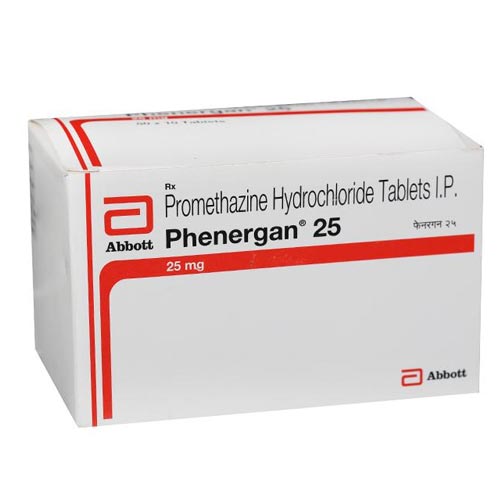Description
Promethazine, a phenothiazine derivative with histamine H1-blocking, antimuscarinic, and sedative properties, is in a group of drugs called phenothiazines (FEEN-oh-THYE-a-zeens). It works by changing the actions of chemicals in your brain. Promethazine also acts as an antihistamine. It blocks the effects of the naturally occurring chemical histamine in your body.
Promethazine is used to treat allergy symptoms such as itching, runny nose, sneezing, itchy or watery eyes, hives, and itchy skin rashes. It also prevents motion sickness, and treats nausea and vomiting or pain after surgery. It is also used as a sedative or sleep aid.
Promethazine is not for use in treating symptoms of asthma, pneumonia, or other lower respiratory tract infections. It is used as an antiallergic, in pruritus, for motion sickness and sedation.
Pharmacodynamics
Promethazine, a phenothiazine, is an H1-antagonist with anticholinergic, sedative, and antiemetic effects and some local anesthetic properties. Promethazine is used as an antiemetic or to prevent motion sickness.
Associated Conditions: Allergic edema, Allergic urticaria,Anaphylactic ReactionConjunctivitis, Seasonal Allergic, Coughing, Dermographism, Motion Sickness, Nasal Stuffiness, Postoperative pain, Seasonal Allergic Rhinitis (SAR), Vasomotor Rhinitis, Acute Allergic Reactions, Perioperative nausea and vomiting, Upper respiratory symptoms.
Mechanism of action
Like other H1-antagonists, promethazine competes with free histamine for binding at H1-receptor sites in the GI tract, uterus, large blood vessels, and bronchial muscle. The relief of nausea appears to be related to central anticholinergic actions and may implicate activity on the medullary chemoreceptor trigger zone.
Side effects
All medicines may cause side effects, but many people have no, or minor, side effects.Some medical conditions may interact with Promethazine.
Tell your doctor or pharmacist if you have any medical conditions.
Common promethazine side effects may include: drowsiness, dizziness, ringing in your ears, double vision, feeling nervous, dry mouth or tired feeling, sleep problems (insomnia).
This is not a complete list of all side effects that may occur. If you have questions about side effects, contact your health care provider.


Reviews
There are no reviews yet.